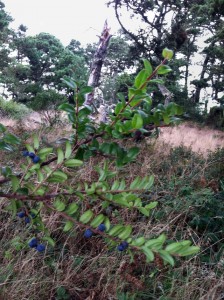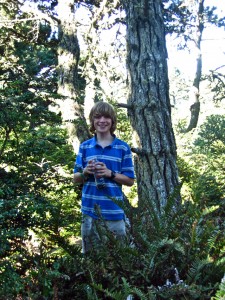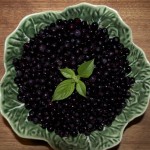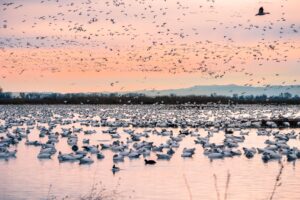A blindfolded boy with shaggy hair and worn out blue jeans stumbles down a trail and through thick coyote brush, led by two other boys and their parents.
“Why do I have to wear this, Jackson?” he asks.
“Our picking spot’s secret, and we’re going to keep it that way,” I say.
Through the brush and misty fog we come upon an overgrown junction.
“You can take your blindfold off now if you would like,” I say.
“Finally,” he says.

It’s mid September and as the days begin to shorten and the leaves begin to fall, huckleberries cluster in the forest. This is the ideal time to pick and every year, my family and I venture to the lush hills above Tomales Bay to harvest these succulent native plants.
My great, great, great grandparents Louis and Dehlia Selby, who lived in Oakland, fell in love with the raw beauty of the area and established a summer camp in the late 1800s known as Camp Azulikit (“As You Like It”). The camp evolved into a summer community and eventually became the permanent hamlet of Inverness. Since then, my mother’s side of the family has spent their summers sailing on the bay and foraging for huckleberries in the fall.
This year my family and I decided to bring my Danish friend, Andreas. He was excited to be invited along and willingly agreed to the blindfold.
Onwards from the junction the landscape changes dramatically. We now trek under a thick canopy of bishop pines, tan oaks and bay laurels. The understory is carpeted in sword ferns, sticky monkey flower, poison oak and huckleberries.
“We’re almost there,” shouts my younger brother, Owen, with glee.
Dense huckleberry plants interspersed with shiny red poison oak engulf the trail. The bushes are laden with navy blue and black berries. Everyone stakes out a spot and begins to pick. With my yogurt container in hand, I carefully select the ripest berries and let them plop in.

Picking huckleberries is not as painful as blackberry-picking, but it is much more time consuming. A huckleberry is slightly smaller and darker than your average blueberry. They grow in thick bunches on stems generally towards the middle to the crown of the bush. There are two different species of berries, an East Coast variety called Gaylussacia, and the West Coast Vaccinium. On the coast, we get the California huckleberry variety, Vaccinium Ovatum, and it’s a good food source for many wildlife. Deer, elk and rabbit graze on the foliage, while the berries feed chipmunks, black bear, mice, thrushes, scarlet tanagers, bluebirds, and other songbirds. And of course, people.
I pick nearly every ripe one from a bush, yet my container is only halfway full.
“Hey, Andreas want to move to another spot?” I ask.
We make our way up a barely visible deer trail until it disappears into dense scrub. Then comes the bushwhacking. I took the lead climbing over a rotting bishop pine log. On the other side we are greeted with more scrub. Plenty of huckleberry plants, but no berries.
“There’s not enough light down here for the berries to grow, we need to go higher up,” I say.
We are nearly to the top of the slope where we we see faint rays of light illuminating the landscape. Then we come upon the thickest wall of scrub yet. The only way to get around is by crawling under. Yogurt container in hand I drop to the ground and army crawl between a narrow opening in the thicket. Andreas follows my lead.
Halfway through I looked down and to my horror I spot my worst enemy.
“We’re crawling through poison oak,” I say, glumly.
It’s too late to turn back and the damage has been done. I power through the last few feet to the other side and spring to my feet. The plants are carpeted in the biggest berries I had ever seen! Andreas pops his head out of the brush, and we pick, filling our containers in no time with plenty leftover to eat. In the distance I hear the faint voice of my father calling us. We find an alternate route back and show off our rewards.

“Wow,” my mother says. “I hope you didn’t have to go through poison oak to get these.”
“No comment,” I say.
The next night I’m restless. Calamine lotion covers my legs arms and chest. The one thing that consoles me when I try to drift to sleep is the thought of huckleberry pancakes.
I wake up to a familiar smell. Rushing downstairs in my pajamas, I see pancakes piled high. The sweet yet tangy tastes of the berries stimulates my taste buds.
“So was it worth it getting poison oak, for these pancakes?,” my mom asks.
“Oh, yeah,” I say.

Jackson Karlenzig, currently a senior at Drake High School, is an avid wildlife enthusiast and intern at Bay Nature. In his spare time he enjoys surfing, backpacking, mountain biking and photography.





